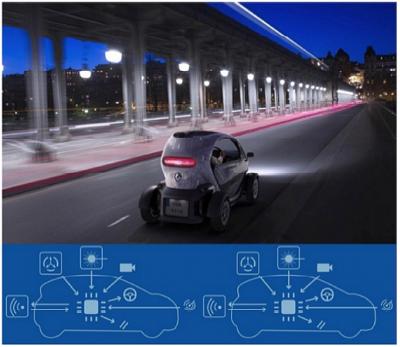Integrated Cooperative Automated Vehicles (i-CAVE)
Summary of the project
This research program addresses current transportation challenges regarding throughput and safety with an integrated approach to automated and cooperative driving. In i-CAVE, a cooperative dual mode automated transport system is researched and designed, consisting of dual mode vehicles which can be driven automatically and manually to allow maximum flexibility. The program integrates technological roadmaps for automated and cooperative driving, accelerating the development of novel transportation systems addressing today's and future mobility demands.
Our Contribution
Our research aims to implement RADAR-based communication, allowing advanced driver assistance systems to be used as both sensors and communication devices, realizing a more robust and synergetic approach to sensing and communication for safe high-speed automated and cooperative driving. To address interaction capabilities between vehicles and environment, we focus on radar processing methods with signals that allow for communication functionality.
Research Questions
-
The first research question is to study waveforms, which are capable of combining sensing and communication functions.
-
A second research question relates to the fact that as soon as the monostatic radar has to process its own transmitted signals, which are reflected by targets, and the communication channel receiver processes signals, which are transmitted by other radars, the processing chains of these signals have to be effectively separated to minimize cross-functional channel interferences. The effectiveness and reliability of such methods will be studied in relation with the available precision of synchronization between multiple radar units.
-
A third research problem relates to the study on digital beamforming on receive and/or transmit to optimally mitigate in the radar processing chain the external and cross-functional channels interferences, clutter and multi-path propagation effects.
-
A fourth research question relates to the potential precision improvement for localization and tracking of all involved in vehicle to vehicle (V2V) communication vehicles. The idea is to develop adaptive to current environmental situation, information processing scheme which will fuse the standard radar information with information available from communication channel about signals time of arrival from other vehicles and will provide a possibility to extend the stand-alone radar node to a distributed radar system with improved performances and extended capabilities.

Project data
| Researchers: | Faruk Uysal, Olexander Yarovoy, Max Schöpe |
|---|---|
| Starting date: | January 2017 |
| Closing date: | December 2021 |
| Sponsor: | STW |
| Partners: | Eindhoven University of Technology, Eindhoven; University of Twente, Enschede; University of Amsterdam; Radboud University, Nijmegen |
| Users: | NXP; AutomotiveNL; Technolution |
| Contact: | Faruk Uysal |